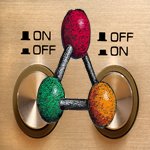
Frankly, some researchers didn't think what we were attempting was possible because standard descriptions in physics, for example the Stokes equation for viscosity indicated that the system might not work. But viscous forces do not apply at the nano-scale," says Dr Keith Firman, Reader in Molecular Biotechnology at Portsmouth University and coordinator of the Mol-Switch project, funded under the European Commission’s FET (Future and Emerging Technologies) initiative of the IST programme. "However, we got our molecular switch to work."
Team develops DNA switch to interface living organisms with computers from PhysOrg.com
Researchers at the University of Portsmouth, UK, have developed an electronic switch based on DNA - a world-first bio-nanotechnology breakthrough that provides the foundation for the interface between living organisms and the computer world.
But the DNA switch has immediate practical application in toxin detection, and could be used in a biodefence role as a biological sensor to detect airborne pathogens.
[...]
No comments:
Post a Comment